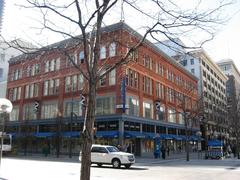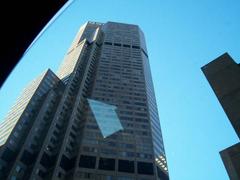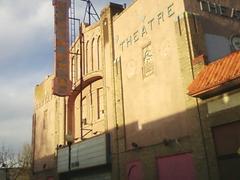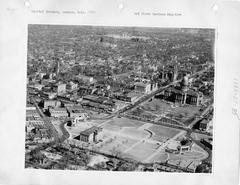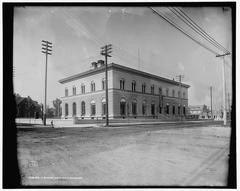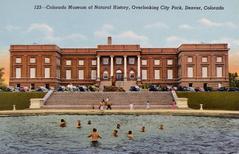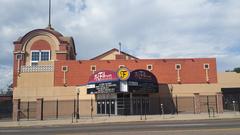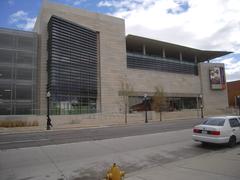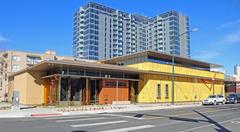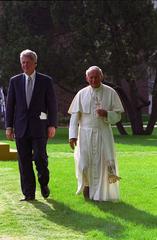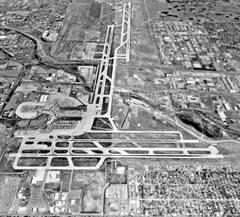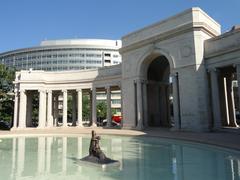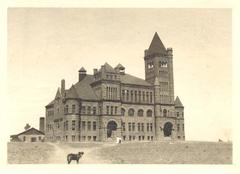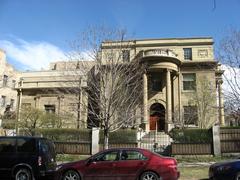Sanderson Gulch Park Denver: Visiting Hours, Tickets, and Travel Guide
Date: 14/06/2025
Introduction to Sanderson Gulch Park and Its Significance
Sanderson Gulch Park, set in the heart of southwest Denver, stands as a living testament to the city’s vision of integrating nature, recreation, and community into its urban landscape. This nearly five-mile linear greenway follows the natural course of Sanderson Gulch, offering visitors scenic multi-use trails, restored native habitats, and educational features. Open daily from dawn to dusk with free admission, Sanderson Gulch Park is easily accessible by car, bike, and public transit, making it a welcoming destination for both locals and visitors.
Originally a utilitarian drainage channel, Sanderson Gulch underwent decades of transformation through urban planning and environmental stewardship. Its evolution, part of Denver’s broader initiative to embed green spaces within the city, showcases a commitment to flood mitigation, habitat restoration, and community collaboration. The park’s history and ongoing enhancements highlight Denver’s dedication to sustainable urban infrastructure, ecological health, and equitable access to natural spaces, especially in historically underserved neighborhoods (Denver Parks & Recreation Projects; Dwell Denver).
Visitors can explore revitalized waterways, native pollinator gardens, an outdoor classroom, and interpretive signage that brings the gulch’s ecological and cultural significance to life. The park’s extensive trail system connects neighborhoods such as Harvey Park, Ruby Hill, and Athmar Park, fostering both connectivity and active transportation. Sanderson Gulch Park is also a focal point for environmental education, volunteerism, and seasonal community events, drawing in those who wish to engage with and care for this dynamic urban oasis (CityCast Denver).
Whether you’re planning a peaceful walk, a family-friendly outing, or an educational adventure, Sanderson Gulch Park offers a vibrant slice of Denver’s natural and community spirit. This guide covers everything you need to know, from historical context and ecological highlights to practical visitor tips and nearby attractions (Ruby Hill Denver Events).
Contents
- Introduction
- Visiting Hours and Admission
- Directions and Parking
- Historical Evolution of Sanderson Gulch Park
- Community Engagement and Significance
- Trail System and Connectivity
- Waterway and Floodplain Restoration
- Ecological Corridor and Habitat
- Pollinator Gardens and Native Plantings
- Outdoor Classroom and Environmental Education
- Recreational Amenities and Nearby Attractions
- Special Events and Guided Tours
- Visitor Tips
- Frequently Asked Questions (FAQ)
- Visuals and Interactive Features
- Future Enhancements
- Conclusion and Call to Action
Visiting Hours and Admission
Hours: Sanderson Gulch Park is open daily from dawn to dusk.
Admission: Free, with no tickets or reservations required.
Enjoy nearly five miles of multi-use trails, scenic habitats, and nature-based amenities throughout the day. The park’s open hours and free access make it ideal for spontaneous visits and community gatherings.
Directions and Parking
By Car: Major access points are near W. Mississippi Avenue, S. Federal Boulevard, W. Florida Avenue, and W. Arkansas Avenue.
Parking: Public parking is available at trailheads and nearby parks, such as Harvey Park and Ruby Hill Park. Street parking is limited but available near some entrances.
By Public Transit: Several RTD bus routes serve the area, with stops close to park entrances along Florida Ave and Arkansas Ave.
By Bike: The park is bike-friendly and connects to Denver’s broader bike trail network.
Historical Evolution of Sanderson Gulch Park
Early Denver Parks and Urban Development
Denver’s green space legacy dates back to the 19th century, when city leaders realized the importance of public parks for urban quality of life. From the city’s first greenspace at Curtis Park in the 1870s, advocates worked to secure parklands citywide (Discover Denver). While Sanderson Gulch was not among the earliest parks, its preservation as a natural corridor aligns with this tradition.
As neighborhoods like Harvey Park and Ruby Hill expanded in the mid-20th century, the city recognized Sanderson Gulch’s potential as both a flood-mitigation asset and a linear park, leading to its transformation into a community greenway (Dwell Denver).
Transformation into a Community Asset
Over recent decades, Sanderson Gulch transitioned from a functional drainage channel to a cherished urban park. Restoration projects focused on habitat improvement, trail development, and public education, with city investment supported by the Parks Legacy Fund, Elevate Denver, and Rise Bond programs. Community input has guided upgrades such as trail resurfacing, interpretive signage, and habitat restoration (Denver Parks & Recreation Projects).
Community Engagement and Significance
Neighborhood Connectivity and Social Value
The park’s trails connect Harvey Park, Ruby Hill, Athmar Park, and Baker, providing a safe and scenic corridor for walking, jogging, and biking. This connectivity strengthens neighborhood bonds and fosters a shared sense of stewardship (Dwell Denver; CityCast Denver).
Inclusive Planning and Public Participation
Ongoing improvements are shaped by public input, with Denver Parks & Recreation hosting meetings, surveys, and community workshops. Recent upgrades include smoother trails, improved lighting, and wayfinding signage, ensuring the park is welcoming for all ages and abilities (Denver Parks & Recreation Projects).
Environmental Education and Stewardship
Interpretive signs along the trail highlight the gulch’s ecological role, native species, and the value of urban waterways. Schools and local organizations use the park for field trips and volunteer projects, cultivating environmental awareness and stewardship.
Ongoing and Future Projects
Current and planned projects focus on accessibility, habitat restoration, and enhanced recreational amenities, all guided by regular five-year planning cycles and community feedback (Denver Parks & Recreation Projects).
Trail System and Connectivity
The Sanderson Gulch Trail is a paved, multi-use path stretching nearly five miles from Ruby Hill to the South Platte River. It serves cyclists, runners, and walkers, and links to the major north-south South Platte River Trail. Upgrades funded by a $21 million investment (completion expected by 2028) will enhance culverts, under-crossings, and multi-use paths, improving safety and accessibility.
Waterway and Floodplain Restoration
A defining feature of the park is its restored waterway, where engineered box culverts and a naturalized stream channel have removed hundreds of properties from the floodplain while supporting ecological health. The riparian corridor now provides habitat for birds and pollinators and helps filter urban runoff before it enters the South Platte River.
Ecological Corridor and Habitat
Sanderson Gulch Park’s naturalized stream, wetlands, and native plantings form an ecological corridor that attracts birds, pollinators, and small mammals. Seasonal wildflowers and mature trees enhance the park’s natural beauty, making it a prime spot for nature walks and birdwatching.
Pollinator Gardens and Native Plantings
The park is home to a 12-acre pollinator garden, established with community support and featuring drought-tolerant native perennials. These gardens provide critical habitat for bees, butterflies, and other pollinators, and offer vibrant photography opportunities throughout the growing season.
Outdoor Classroom and Environmental Education
An innovative outdoor classroom hosts workshops, school programs, and community events focused on native plants, pollinator conservation, and urban ecology. Interpretive signage and hands-on activities engage visitors of all ages.
Recreational Amenities and Nearby Attractions
Facilities include a renovated playground, dog park (near W. Arkansas Ave. and S. Navajo St.), and open spaces for picnics and relaxation. Adjacent Ruby Hill Park offers sports fields, a sledding hill, and an amphitheater. The South Platte River Trail and local eateries are also nearby.
Special Events and Guided Tours
The park regularly hosts community clean-ups, educational workshops, and nature walks. Seasonal guided tours highlight the park’s history and ecology—check the Ruby Hill Denver Events page or Denver Parks & Recreation website for upcoming events.
Visitor Tips
- Participate in volunteer events and community programs (Denver Parks & Recreation Projects).
- Stay on designated trails and respect wildlife.
- Join local groups or neighborhood associations for stewardship opportunities.
- Use GPS or park maps at trail junctions, especially where the gulch meets the South Platte River Trail.
- Bring water and sun protection.
- Early mornings and evenings are best for wildlife watching and photography.
Frequently Asked Questions (FAQ)
Q: What are the park’s hours?
A: Open daily from dawn to dusk.
Q: Is there an admission fee?
A: No, the park is free to enter and use.
Q: Are dogs allowed?
A: Yes, dogs must be leashed except in designated off-leash areas.
Q: Is the park accessible?
A: Most trails and facilities are ADA-compliant, though some natural areas may have uneven terrain.
Q: Are there restrooms or water fountains?
A: Facilities are limited within Sanderson Gulch Park; restrooms are available at Ruby Hill and Harvey Park.
Q: Are there regular guided tours?
A: Occasionally, especially during community events. Check the park’s event calendar for details.
Visuals and Interactive Features
Interactive maps, photo galleries, and virtual tours are available on the Denver Parks & Recreation website and via QR codes at trailheads. The Audiala app offers guided audio tours and event alerts to enhance your visit.
Future Enhancements
By 2028, improvement projects will deliver new culverts, expanded under-crossings, enhanced floodplain management, and continued stream restoration. These efforts will further elevate Sanderson Gulch Park’s role as a premier urban greenway.
Explore the Sanderson Gulch Monument – A Denver Historical Landmark
The Sanderson Gulch Monument, located near W. Florida Avenue and W. Arkansas Avenue, commemorates the watershed’s role in Denver’s history and flood mitigation efforts. Interpretive panels explain the gulch’s ecological and community significance. The monument and adjacent park areas are open daily from dawn to dusk, with free admission. Seasonal guided tours by Denver Parks & Recreation offer deeper insights into the area’s natural and cultural legacy.
Summary and Visitor Tips
Sanderson Gulch Park exemplifies Denver’s innovative approach to green space by blending historical significance, environmental restoration, and community engagement. Visitors enjoy nearly five miles of trails, restored waterways, and educational features. Supported by city funding and community input, the park remains responsive to evolving needs and challenges (Denver Parks & Recreation Projects).
To make the most of your visit:
- Use public transit or bike to avoid limited parking.
- Download the Audiala app for interactive maps and event updates.
- Join local volunteer efforts and stay engaged with community organizations.
- Capture photos of native gardens, wildlife, and restored water features.
- Explore nearby parks and cultural sites for a full day’s adventure.
Sanderson Gulch Park invites you to experience its trails, discover its history, and join a vibrant community dedicated to preserving Denver’s natural heritage (Discover Denver; Dwell Denver).
Sources and Further Information
- Discover Denver, 2024, City of Denver Historical Archives (Discover Denver)
- Dwell Denver, 2024, Neighborhood and Park Development Blog (Dwell Denver)
- Denver Parks & Recreation Projects, 2024, Official City of Denver (Denver Parks & Recreation Projects)
- CityCast Denver, 2024, Neighborhood Guides (CityCast Denver)
- Ruby Hill Denver Events, 2024, Community Event Calendar (Ruby Hill Denver Events)
